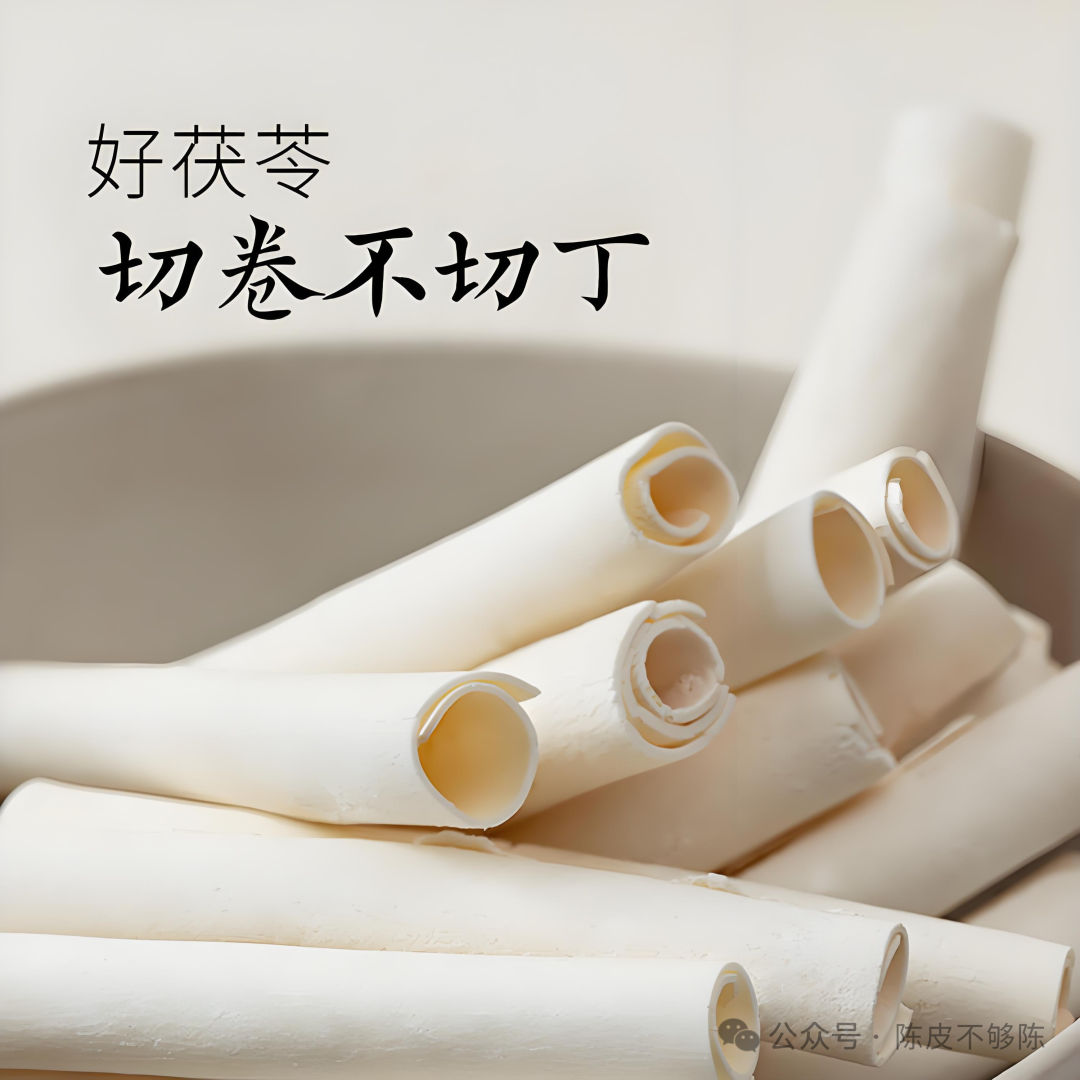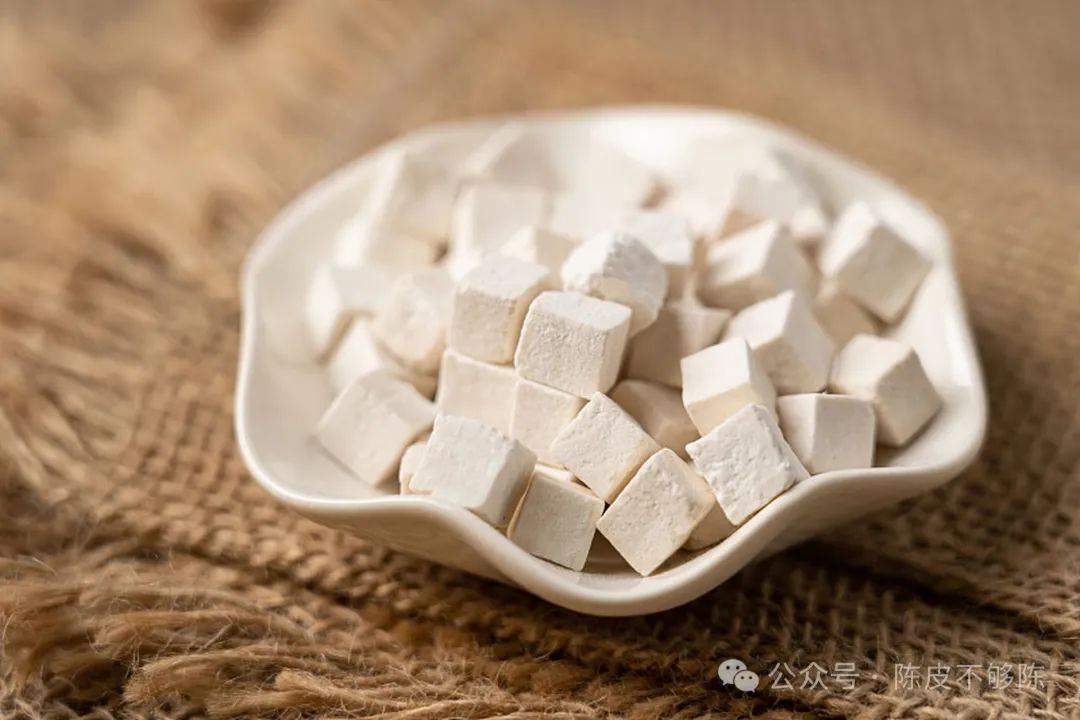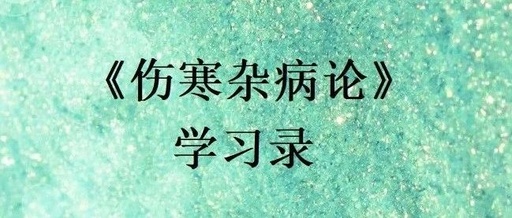Introduction: The following content is a study note based on the teachings of Teacher Zhang Yujing regarding the interpretation of the “Shang Han Lun” and its medicinal evidence. Each herb is discussed from four aspects: origin, classical texts, etiology and pathogenesis, and clinical applications.

1. Origin
Poria (Fu Ling) is the sclerotium of the fungus Poria cocos, belonging to the family Polyporaceae, which primarily parasitizes the roots of Pinaceae plants such as Pinus massoniana (Masson pine) or Pinus tabuliformis (Chinese red pine). It is mainly produced in Zhejiang, Yunnan, Hubei, and Anhui provinces. Currently, both wild and cultivated varieties exist, and many scholars still consider the variety from Yunnan as Yun Ling, which is of the highest quality.
2. Key Texts
The maximum dosage of Poria is half a jin, which is involved in three formulas, detailed as follows:
After sweating, if the person experiences palpitations below the navel and desires to run away, Fu Ling Gui Zhi Gan Cao Da Zao Tang (Poria, Cinnamon Twig, Licorice, and Jujube Decoction) is indicated.
Poria: half a jin; Cinnamon Twig: four liang, peeled; Licorice: two liang, roasted; Jujube: fifteen pieces, split.
Combine the four ingredients with one dou of Gan Lan water, first boil Poria, reduce by two sheng, then add the other herbs, boil to obtain three sheng, strain, and take one sheng warm, three times a day.
Preparation of Gan Lan water: Take two dou of water, place it in a large basin, and stir it with a ladle until five or six thousand beads appear on the surface, then use this water.
—— “Shang Han Lun: Differentiation of Tai Yang Disease Pulse and Symptoms”
If there is stomach reversal, vomiting, and thirst for water, Fu Ling Ze Xie Tang (Poria and Alisma Decoction) is indicated.
Poria: half a jin; Alisma: four liang; Licorice: two liang; Cinnamon Twig: two liang; Bai Zhu (White Atractylodes): three liang; Fresh Ginger: four liang.
The formula for Fu Ling Ze Xie Tang states in the “Wai Tai” that it treats thirst with a pulse that is absent, and stomach reversal with vomiting of food, with one sheng of wheat.
Combine the six ingredients with one dou of water, boil to obtain three sheng, then add Alisma, and boil again to obtain two and a half sheng, take eight he warm, three times a day.
—— “Jin Gui Yao Lue: Vomiting and Diarrhea”
If there is difficulty in urination, Pu Huai San (Poria Powder) is indicated, as well as Hua Shi Bai Yu San (Talc and White Fish Powder) and Fu Ling Rong Yan Tang (Poria and Salt Decoction).
Poria: half a jin; Bai Zhu: two liang; Rong Yan: one ball, size of a bullet.
First, decoct Poria and Bai Zhu, then add Rong Yan, and decoct again, dividing into three warm doses.
—— “Jin Gui Yao Lue: Thirst and Difficulty in Urination”
Multiple formulas are involved in the modifications of the prescriptions, and here are a few specific texts:
If there is unresolved exterior syndrome, water qi in the heart, dry retching, fever and cough, or thirst, or diarrhea, or choking, or difficulty in urination, fullness in the lower abdomen, or wheezing, Xiao Qing Long Tang (Minor Blue Dragon Decoction) is indicated.
Ma Huang (Ephedra): remove the joints; Shao Yao (Peony): three liang; Xi Xin (Asarum): three liang; Gan Jiang (Dried Ginger): three liang; Gan Cao (Licorice): three liang; Gui Zhi (Cinnamon Twig): three liang, peeled; Wu Wei Zi (Schisandra): half a sheng; Ban Xia (Pinellia): half a sheng, washed.
Combine the eight ingredients with one dou of water, first boil Ma Huang, reduce by two sheng, remove the foam, then add the other herbs, boil to obtain three sheng, strain. Take one sheng warm.
Modification: If there is difficulty in urination and fullness in the lower abdomen, remove Ma Huang and add Poria four liang.
If there is a cold and heat alternating, chest and flank fullness, dislike of food, irritability, or chest discomfort without vomiting, or thirst, or abdominal pain, or hardness in the flank, or palpitations, difficulty in urination, or no thirst, slight fever, or cough, Xiao Chai Hu Tang (Minor Bupleurum Decoction) is indicated.
Chai Hu (Bupleurum): half a jin; Huang Qin (Scutellaria): three liang; Ren Shen (Ginseng): three liang; Ban Xia: half a sheng, washed; Gan Cao: three liang, roasted; Sheng Jiang (Fresh Ginger): three liang, sliced; Da Zao (Jujube): twelve pieces, split.
Combine the seven ingredients with one dou and two sheng of water, boil to obtain six sheng, strain, then decoct again to obtain three sheng. Take one sheng warm, three times a day.
Modification: If there are palpitations and difficulty in urination, remove Huang Qin and add Poria four liang.
—— “Shang Han Lun: Differentiation of Tai Yang Disease Pulse and Symptoms”
If there is a Shao Yin disease lasting two to three days, and then four to five days with abdominal pain, difficulty in urination, heaviness and pain in the limbs, and diarrhea, this indicates water qi. The person may cough, have difficulty in urination, diarrhea, or vomiting, Zhen Wu Tang (True Warrior Decoction) is indicated.
Poria: three liang; Shao Yao: three liang; Bai Zhu: two liang; Sheng Jiang: three liang, sliced; Fu Zi (Aconite): one piece, peeled, broken into eight pieces.
Combine the five ingredients with eight sheng of water, boil to obtain three sheng, strain, and take seven he warm, three times a day.
Modification: If there is difficulty in urination, remove Poria.
If there is a Shao Yin disease with four reversals, the person may cough, have palpitations, difficulty in urination, abdominal pain, or heavy diarrhea, Si Ni San (Four Reversal Powder) is indicated.
Gan Cao: roasted; Zhi Shi (Bitter Orange): broken, soaked in water, roasted dry; Chai Hu: three liang; Shao Yao: three liang.
Combine the four ingredients, each ten parts, pound and sift, and mix with white drink to take one inch, three times a day.
Modification: If there is difficulty in urination, add Poria five fen.
—— “Shang Han Lun: Differentiation of Shao Yin Disease Pulse and Symptoms”
If there is cholera, headache, fever, body aches, and a desire to drink water, Wu Ling San (Five Poria Powder) is indicated; if there is more cold and no desire for water, Li Zhong Wan (Regulating the Center Pill) is indicated.
Ren Shen: three liang; Gan Jiang: three liang; Gan Cao: three liang, roasted; Bai Zhu: three liang.
Combine the four ingredients, pound and sift, mix with honey to form pills the size of a quail egg. Take with boiling water several times, and take one pill, crushed, warm, three to four times a day, and two at night. If the abdomen is not hot, increase to three or four pills, but do not exceed the decoction.
For decoction: use four ingredients, cut according to weight, use eight sheng of water, boil to obtain three sheng, strain. Take one sheng warm, three times a day.
Modification: If there are palpitations, add Poria two liang.
—— “Shang Han Lun: Differentiation of Cholera Disease Pulse and Symptoms”
If there is sudden vomiting, fullness below the heart, and water between the diaphragm, dizziness and palpitations, Xiao Ban Xia Jia Fu Ling Tang (Minor Pinellia Decoction with Poria) is indicated.
Ban Xia: one sheng; Sheng Jiang: half a jin; Poria: three liang.
Combine the three ingredients with seven sheng of water, boil to obtain one and a half sheng. Divide and take warm.
If there is phlegm and fluid, it should be treated with warm herbs. If there is phlegm and fluid in the heart, fullness in the chest and flanks, and dizziness, Ling Gui Zhu Gan Tang (Poria, Cinnamon, Atractylodes, and Licorice Decoction) is indicated.
Poria: four liang; Gui Zhi: three liang; Bai Zhu: three liang; Gan Cao: one liang.
Combine the four ingredients with six sheng of water, boil to obtain three sheng. Divide and take warm three times, and urination will be smooth.
For shortness of breath with slight fluid, it should be resolved through urination, Ling Gui Zhu Gan Tang is indicated, and Shen Qi Wan (Kidney Qi Pill) is also indicated.
—— “Jin Gui Yao Lue: Phlegm and Cough Disease Pulse and Symptoms”
If there is chest obstruction, chest qi blockage, and shortness of breath, Fu Ling Xing Ren Gan Cao Tang (Poria, Apricot Kernel, and Licorice Decoction) is indicated, and Ju Zhi Sheng Jiang Tang (Tangerine Peel, Bitter Orange, and Ginger Decoction) is also indicated.
Poria: three liang; Xing Ren (Apricot Kernel): fifty pieces; Gan Cao: one liang.
Combine the three ingredients with one dou of water, boil to obtain five sheng. Take one sheng warm, three times a day, without fail.
—— “Jin Gui Yao Lue: Chest Obstruction, Heart Pain, and Shortness of Breath Disease Pulse and Symptoms”
The simplest formula is Kui Zi Fu Ling San (Kui Seed and Poria Powder), detailed as follows:
If there is pregnancy with water qi, heaviness in the body, difficulty in urination, chills, and dizziness upon rising, Kui Zi Fu Ling San is indicated.
Kui Zi: one jin; Poria: three liang.
Combine the two ingredients, pound into powder. Take one inch, three times a day, and urination will improve.
—— “Jin Gui Yao Lue: Women’s Pregnancy Disease Pulse and Symptoms”
3. Etiology and Pathogenesis
The symptoms of dizziness, palpitations, and difficulty in urination frequently appear in the texts, accompanied by symptoms such as heaviness in the body, water qi, thirst, and phlegm fluid. These symptoms and pathogenesis revolve around the discussion of abnormal water metabolism. Therefore, it can be inferred that dizziness, palpitations, and difficulty in urination are caused by the accumulation and flow of phlegm, dampness, fluid, and water toxicity due to disordered water metabolism (dizziness in the upper jiao, palpitations in the middle jiao; difficulty in urination in the lower jiao).
Thus, dizziness, palpitations, and difficulty in urination are merely symptoms, while the true pattern is the diffusion of phlegm, dampness, fluid, and water toxicity throughout the three jiao.
Sweating and promoting urination (opening the ghost gate and cleansing the residence) are the two main methods for treating fluid syndrome. Bai Fu Ling (White Poria) is sweet, neutral, slightly cold, enters the lungs and reaches the spleen, passing through the three jiao, and its mild diuretic properties guide internal water and dampness downward, expelling it through urination. This is also the mechanism behind the modification of Zhen Wu Tang, where if there is difficulty in urination, Poria is removed. Poria treats water by facilitating the flow of water pathways, unlike the drying and dispersing properties of Ban Xia (Pinellia) and Chen Pi (Aged Tangerine Peel) which expel dampness and water.
Poria: sweet, neutral. It is indicated for chest and flank qi reversal, worry, fright, palpitations, pain below the heart, cold and heat fullness, cough, dry mouth, and difficulty in urination. Long-term use calms the spirit, nourishes the mind, suppresses hunger, and prolongs life.
—— “Shen Nong Ben Cao Jing”
Comparatively, the understanding and application of Poria by the master Zhang Zhongjing is consistent with the “Ben Cao”. In addition to the aforementioned symptoms of dizziness, palpitations, and difficulty in urination, the text also discusses the treatment of worry, fright, and palpitations, which modern herbal medicine textbooks summarize as calming the heart and mind. However, worry, fright, and palpitations are an intensified version of unsettled spirit.
If sweating does not resolve the illness, and there is restlessness, Fu Ling Si Ni Tang (Poria Four Reversal Decoction) is indicated.
Poria: four liang; Ren Shen: one liang; Fu Zi: two pieces, raw, peeled, broken into eight pieces; Gan Cao: two liang, roasted; Gan Jiang: one and a half liang.
Combine the five ingredients with five sheng of water, boil to obtain three sheng, strain. Take seven he warm, two times a day.
—— “Shang Han Lun: Differentiation of Tai Yang Disease Pulse and Symptoms”
Poria is not merely for calming the heart and mind. If the purpose is to calm the spirit, why not use Long Gu (Dragon Bone), Mu Li (Oyster Shell), or Suan Zao Ren (Sour Jujube Seed), or Bai Zi Ren (Arborvitae Seed)? Moreover, in this formula, Poria is used in a dosage of four liang. The term “restlessness” in this context indicates that the patient is in a state of Shao Yin Yang deficiency, with internal cold and binding. The fluids encounter cold and congeal, leading to restlessness due to the water qi rising to the heart. In treatment, on one hand, Si Ni Tang is used to revive yang and rescue the reverse; on the other hand, a heavy dose of Poria is used to move water and disperse the cold binding, applying layered treatment, addressing both upper and lower issues simultaneously.
In traditional Chinese medicine, the form, color, aroma, and taste of herbs are important. Poria is sweet and neutral, white in color, and has a downward trend overall.
When ingested, it travels through the stomach, dispersing vital energy, ascending to the spleen, where the spleen qi disperses the essence, returning to the lungs, regulating the water pathways, and descending to the bladder, distributing water essence throughout the body, harmonizing the five meridians.
—— “Su Wen: Discussion on the Meridians”
Water can enter and exit the human body under two conditions: one is that the organ functions are intact and can cooperate with each other; the other is that the pathways of the three jiao are unobstructed.
Therefore, the key point in using Poria is “water stagnation (disordered water metabolism)” to regulate the water essence metabolism pathways of the three jiao, using qi as the means; if the body presents a state of yin deficiency, caution should be exercised!
Poria: used in cases of disordered water essence metabolism with symptoms of dizziness, palpitations, difficulty in urination, and restlessness, with a tongue that is often enlarged (indicating water essence obstruction or stagnation), the tongue body should not be thin, aiming to restore the normal operation of water essence in the body.
Conclusion:To treat the obstruction of the water pathways in the three jiao and the abnormal rise and fall of qi, using qi as the means.

4. Applications
Poria should be firm in texture, with a brownish outer skin that is slightly shiny, deeply wrinkled, and a white, fine cross-section, with strong adhesive properties being the best. Its processing methods have traditionally been two: either cut while moist and dry in the sun, or take dried Poria, moisten it with water, steam slightly, cut, and dry.
In clinical applications, the soaking time of the herbs should be increased, or Poria should be crushed to increase the contact area between the herbs and the solvent, thereby enhancing the dissolution of various effective components and improving efficacy.
The most common counterfeit of Poria is made from flour or cooked gypsum. If the herb is placed in water and dissolves, it is undoubtedly fake.
Note: The above content is organized by me based on Teacher Zhang Yujing’s Himalaya audio and the interpretation of the “Shang Han Lun” medicinal evidence. The copyright belongs to the original author, and this organization is solely for my personal study and not for commercial use. Please indicate the source if reprinted.
—— To be continued —
❤️ If you like the article, please follow, like, and share to support ❤️

